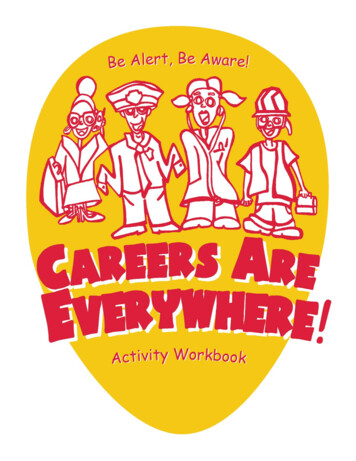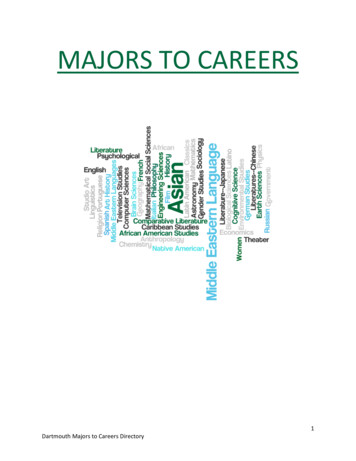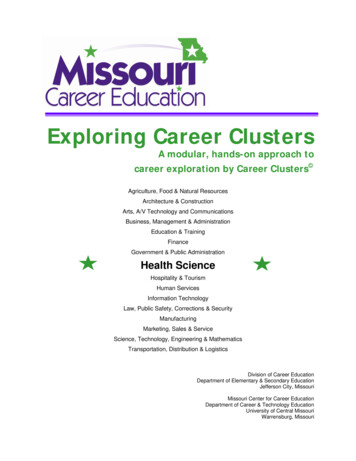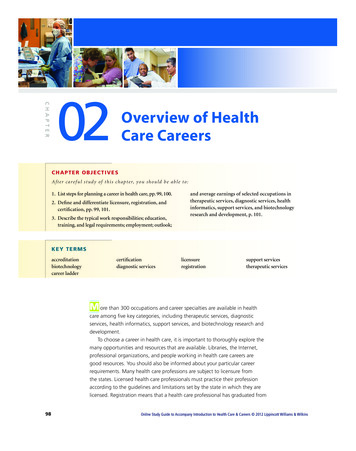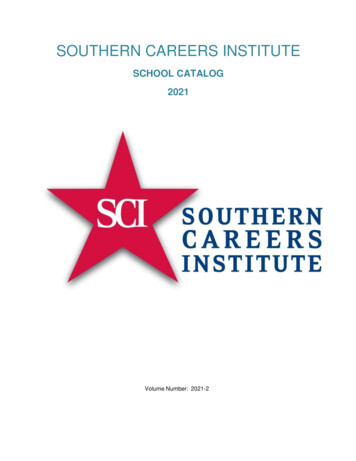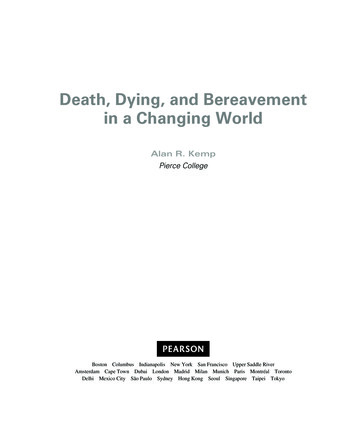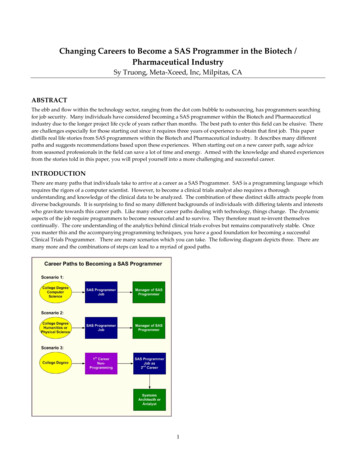
Transcription
Changing Careers to Become a SAS Programmer in the Biotech /Pharmaceutical IndustrySy Truong, Meta‐Xceed, Inc, Milpitas, CAABSTRACTThe ebb and flow within the technology sector, ranging from the dot com bubble to outsourcing, has programmers searchingfor job security. Many individuals have considered becoming a SAS programmer within the Biotech and Pharmaceuticalindustry due to the longer project life cycle of years rather than months. The best path to enter this field can be elusive. Thereare challenges especially for those starting out since it requires three years of experience to obtain that first job. This paperdistills real life stories from SAS programmers within the Biotech and Pharmaceutical industry. It describes many differentpaths and suggests recommendations based upon these experiences. When starting out on a new career path, sage advicefrom seasoned professionals in the field can save a lot of time and energy. Armed with the knowledge and shared experiencesfrom the stories told in this paper, you will propel yourself into a more challenging and successful career.INTRODUCTIONThere are many paths that individuals take to arrive at a career as a SAS Programmer. SAS is a programming language whichrequires the rigors of a computer scientist. However, to become a clinical trials analyst also requires a thoroughunderstanding and knowledge of the clinical data to be analyzed. The combination of these distinct skills attracts people fromdiverse backgrounds. It is surprising to find so many different backgrounds of individuals with differing talents and interestswho gravitate towards this career path. Like many other career paths dealing with technology, things change. The dynamicaspects of the job require programmers to become resourceful and to survive. They therefore must re‐invent themselvescontinually. The core understanding of the analytics behind clinical trials evolves but remains comparatively stable. Onceyou master this and the accompanying programming techniques, you have a good foundation for becoming a successfulClinical Trials Programmer. There are many scenarios which you can take. The following diagram depicts three. There aremany more and the combinations of steps can lead to a myriad of good paths.1
This paper evaluates various different paths that individuals took on their road through clinical SAS programming. There isno one correct path but rather a diverse set. This demonstrates the unique combination of skill sets needed to thrive in thisenvironment. This position has only recently been established so many of the individuals who entered this field did not setout to become a clinical SAS programmer. For many, the journey was unplanned and there were no road maps. They werepioneers and navigated their career path following their intuition and relied on luck. There are many lessons that can begained from these pioneers. The paths which these pioneers paved will provide a clearer vision and set of directions forfuture aspiring SAS programmers who plan to venture on the same roads.ASSOCIATE DIRECTOR OF BIOANALYSIS ‐ DAVID TAPPEIt is not about how good a SAS programmer you are. It is aboutbeing focused on the data and your representation of the data thatleads to success.Starting OutWhen David started out on his first SAS programming position at Syntex in Palo Alto, California in the 80s, this type of workwas not well understood nor well known on the west coast. The term ʺBioanalystʺ used at Syntex for statistical programmerswas foreign and he did not know what to expect.David went to UCLA to obtain his bachelors degree in Mathematics. He then continued his studies at Fresno State in Biologyand did his thesis work in Lymnology, or the study of fresh water ecosystems. His academic experience did not includeformal computer science nor teach him how to program in SAS, but it did include exposure to research methods and statisticsthat he used in his thesis. In fact, David had little formal programming training. He was introduced to programming whenhe took a FORTRAN course at UCLA. Back in the days of punch cards, he used FORTRAN for an ecosystem modeling class ingraduate school. Out of personal interest, he learned BASIC programming on his own while working as a Lab Technician atU.C. Berkeley. As he developed his career, the technical aspects of programming were merely a means to an end. That endwas the data itself and how the data demonstrated meaning when analyzed. The meaning of the data was therefore pivotaland overrode the mechanics of getting there. David gained enough proficiency in programming on the job to perform well inhis job without much formal training.In 1979, David moved to Walnut Creek in the east bay after he had completed his course work in Fresno. He explored jobs inthe bay area and first worked in the department of Materials Science at U.C. Berkeley helping on research projects aimed atfinding ways to utilize coal dust. As that job was ending, he found a job announcement at the U.C. Berkeley placement centerfor a Bioanlyst at Syntex. Syntex was an established pharmaceutical company, but due to the lack of experienced statisticalprogrammers in the bay area at the time, they hired people at entry level. Although he lacked the job specific experience, heapplied for the job at Syntex because he was intrigued by the blend of statistics, health research and programming mentionedin the job announcement. At the time, however, he did not know what a Bioanalyst did or what the job entailed. Thecommute from Walnut Creek to Palo Alto required him to go over the east bay hills, across one of the bay bridges. This addedto his commute totaling about 60 miles. The job had to prove to be a good fit for him to keep up with this grueling commute,even with the help of a carpool. In the end, it was the research aspect and ability to understand the meaning behind that datathat cemented his decision to stay in this field as a career.He began to appreciate the goal of producing study reports summarizing the safety and efficacy results of clinical trials.While he enjoyed programming and developing good SAS programming skills, the output produced by his programs weremore important than the SAS programs. He began to realize that this was the pivotal aspect of the Bionalystʹs job. TheBiostatistician, who was the Bioanalystʹs client, wanted to receive quality output tables representing the study data and itsanalyses results. They were not interested in the quality of the SAS program used to create the tables, so long as theyproduced accurate results.The understanding of the disease that he was working on was another fascinating aspect of the job. He is not clinically trainedas a MD or a RN, but his interest in research and learning about the disease related to a given drug allowed him a unique viewof the data. This was a window through the data which provided meaning that became essential in his work. The interactionswith other team members mostly involved communicating with the Biostatistician. However, it also included interacting withthe other clinical team members, such as the MD in charge of the project. The Biostatistician and Bioanalyst worked togetherclosely in analyzing and producing report tables and graphs. Even though the meaning of the statistics is in the domain of thestatistician, it often ended up with the Bioanalyst needing to interpret their instructions to fill in the gaps. This multi‐facetedaspect of the job kept David interested in the work which sustained and rationalized his long commute for 12 years.2
Growing within the JobAlthough the data kept David interested, he did explore technical aspects of the job as well. He continued to develop his SASprogramming skills by taking some database design courses at U.C. Berkeley Extension. This gave him the opportunity towork on several Oracle database projects. He also was part of the initial Rx/Clinical development team, a joint venturebetween Oracle and Syntex that led to Oracle Clinical, the leading clinical trial database management system used in thepharmaceutical industry.He began to take on management responsibilities, managing both people and projects at Syntex. This continued on in hiscareer at Chiron in Emeryville. He modestly attributed the management of people as being an easy job because the people heworked with were capable and good to work with. Since he had a good understanding of what it took to perform as aBioanalyst, he was able to identify people who had the right balance of research and interest in the data, along with thetechnical programming skills. It was a combination of having the tenacity to understanding the clinical aspects of the datawhile having the technical skills to deliver analysis. This was what David had strived for himself and was what he looked forin forming the teams which he managed.David is now the Associate Director of Bioanalysis at Novartis (formerly Chiron). He is very proud of the team that he puttogether since he started at Chiron. Davidʹs first goal at Chiron was to establish a standard set of reporting macros whichwould handle the standard CRF (Case Report Forms). He decided to have his Bioanalysts balance their workload ofproducing the day‐to‐day analysis and reporting work with developing and maintaining a standard library of macro software.The standard software mostly focused on generating safety summaries since the efficacy data usually varied too muchbetween projects. The difference among studies didnʹt lend itself to standardization. He proceeded to assign Phil to work onLab data, Frances to develop macros for Adverse Events, Rob to work on Demographics and Conmed while David himselfworked on the Dosing information. It was a management style that allowed him to participate in the work firsthand, whilemotivating the team to develop software. This was all implemented on top of the normal study analysis work that they had todo. He enjoyed working on his macro component which organized dosing information into a dosing analysis file and thenjoined this file with time‐dependent events in a study. This allowed integrating a subjectʹs dosing experience with other studydata such as adverse event and efficacy data. For example, an adverse event can occur at any specific time during the study.His macro would then merge this data with the dosing information and added variables such as the exact dose, thecumulative dose, time since last dose, etc. This was derived in association with the adverse event of this event.Davidʹs approach to developing the macro system was to standardize any area where the potential use outweighed thedevelopment and validation costs. Having a standard macro system available provided for consistent analyses across studies,projects and output. It also prevented the programmer from having to do repetitive tasks. This allowed them to focus on theunique efficacy aspects of each study. It made the job easier and more efficient for the Bioanalyst. His team was also moreengaged and interested since the work was more dynamic and became more like a unique puzzle that needs to be solved forevery study.It took a year to develop the 1st version of the software with much of the teamʹs efforts focused on the macro system without alot of competing study analysis work. Later on, it took more time to implement subsequent version releases since theprogrammers usually had project work that took precedence over the standard macro development. David thinks howeverthat this was a more cost effective approach. By giving the development efforts to the senior programmers who work with theanalyses themselves, the development of software was implemented by the same individuals who understand it the most.David has a low key approach to managing his people. He sets out goals and expects his people to work conscientiously andautonomously. He does not see himself as having a draconian style but rather a gentle coach approach. David performs peerreviews and makes suggestions but in general, leaves his people alone. He sees that it is this freedom that allows the talents ofeach individual to thrive and discover the unique balance of various skills to be a successful Bioanalyst.CONSULTING SAS PROGRAMMER – GENEBeing resourceful and learning new things will keep you frombecoming stagnant and become successful as a SAS programmer.Back in the DayGeneʹs introduction to computers and technology started back in high school in the 70ʹs when he used the Texas Instrumentcalculators that allowed him to program equations. He then learned assembly language and machine code on DEC PDP‐11and Zilog Z‐80 microprocessors. Gene enjoyed working at the machine level of these 16 and 8‐bit machines because it taught3
him the fundamentals and rigorous approach towards programming, including debugging programs. He then progressedinto learning the BASIC language. In addition to Geneʹs disposition towards problem solving which attracted Gene towardscomputers, he also had interest in becoming a ʺdoctorʺ so he started his undergraduate work at Johns Hopkins in 1980 on adegree in Biomedical Engineering. This combined his clinical aspirations with his analytical, research‐oriented, engineeringambitions.The university setting, including summer jobs, gave Gene experience working on research projects. Even though he spent alot of time in the lab working on animals, technology was ever present. For example, the research labs had a Radio ShackTRS‐80 computer controlling a dogʹs heart rate. The combination of technology as applied to medical research was fascinatingbecause it was very ʺFrankensteinʺ. Similar to how tinkering with early 8‐bit computers gave Gene the fundamentals ofsoftware development, the laboratory he worked in gave him a foundation for medical research which later aided him in hiswork on clinical trials.Although he did not use SAS yet, Johns Hopkins and his graduate work at Case Western Reserve University did allow Geneto work with BMPD. This was another statistical software package at the time which allowed him to run statistical modelssuch as on ANOVA, T‐TEST which were in routines similar to SAS PROCs.The First JobOne of the first jobs that Gene started to work on after his Masters degree in Biomedical Engineering was working as a DataManager in Los Angeles for a non‐profit organization named Los Angeles Regional Family Planning Council. He worked onprojects dealing with clinical trials on contraceptives such as the IUD and non‐latex condoms. Gene worked closely with thedata in a role as a DBA/Data Manager using dBase III with tasks such as defining the database structure and setting up dataentry screens. He was also introduced to SAS but had limited resources since there were no other SAS programmers in theentire organization. He therefore referred to his manager who had a statistical background, but was limited in SASknowledge and he also used SAS reference manuals. Gene enjoyed learning programming on his own and purchasedadditional SAS manuals directly from SAS Institute to teach the SAS language to himself. .As a Database Manager, Gene worked closely on data discrepancies such as programming edit checks and the process oftransferring data from dBase to SAS via flat ASCII files. Once he had the data in SAS, he was able to generate descriptivestatistics using PROC MEANS, FREQ and UNIVARIATE. The programming practices being conducted were not as formallystructured as in a typical clinical trial. As a policy, permanent analysis files were never saved, but instead the same SASprogram would import the source data, create temporary analysis files, and directly generate statistical reports . At this point,Gene only dabbled in SAS and it had not yet become his main job.After leaving LA, he moved to the San Francisco Bay Area to work for a medical device company dealing with laser eyesurgery named VISX. He sought out this new position as a biomedical engineer, since it matched his college education.Although he did initially accomplish some engineering improvements on their product, his background in working withclinical data ultimately dictated his role at VISX. Since Gene had been working as a data manager, they had placed him in aposition working closely with their DOS‐based Paradox database with analysis in SAS. He continued working on the datadiscrepancy management which was then exported to SAS for analysis. Since this medical device was VISXʹs major productand its major competitor, Summit Technologies, was developing a similar product, there were tremendous timeline pressuresto get the data submitted to the FDA for approval and beat their competitor to the open market. So VISX decided to hire SASconsultants to assist in achieving this goal. Although marketing approval for VISXʹs product was virtually completed inCanada and Europe, they were still in the process of getting approval in the USA and therefore were submitting the clinicaltrial reports to the FDA. Part of Geneʹs responsibilities was to guide the SAS consultants in their job. He was not their formalmanager but he worked closely with them since he understood the meaning of the data and had some experience with SASprogramming. He could bridge the gap between what topics the statisticians wanted to report on and how SAS programmingcould accomplish these tasks. This was an eye opening experience in that for the first time, he discovered that there existedsuch a job where you can program in SAS 100% of the time as a job! This intrigued him since he did not care for theadministrative aspect of the jobs he had seen. These SAS consultants would just come in, focus on their work and were notinvolved in as much meetings or office politics. These guys were ʺdo‐ersʺ not ʺtalkersʺ. They did not have administrativetasks such as dealing with yearly performance reviews and were just there to do a specific job. Gene saw this as a refreshingalternative way of working. He also liked how these consultants had opportunities to experience how different companiesoperated since they did not stay at one company as long as permanent employees. This variety of work kept these consultantson their toes and prevented them from falling into a rut, with boredom and stagnation.4
This insight encouraged Gene to continue to learn more about SAS through the use of the few SAS manuals he had access to.He also learned by seeing sample code that these consultants would share with him. Gene was now spending 50% of his timeworking on SAS which was more than he had ever done before.Transition to ConsultingThere were corporate challenges at VISX which lead to layoffs. This and other management turmoil lead Gene to try out theconsulting world starting with work at Roche Biosciences. It started out as a 3 month contract which is typical for an initialcontract. This introductory period allowed the company to evaluate the consultant to see if it worked out without making abig commitment. If things went smoothly and there was work to be done, it was normally extended. Gene worked on theprecursor to Oracle Clinical known as Rx/Clinical which is the clinical trials relational database jointly developed by Oracleand Syntex, which later became Roche Biosciences. Even though he started out working in the role as a data management,Gene grew into the position of a SAS programmer and continued to work as a consultant at Roche for three and a half years.This was where he learned the majority of his SAS programming skills. During these same years, Gene noticed that therewere some individuals in this large organization who began to have a ʺDMVʺ mentality. After years of working in abureaucratic organization, they lacked the desire to learn new things and became less motivated. Some of his colleagues werein the same company for tens of years. He began to see how this stagnation crept into his work routine as well, even thoughhe was a consultant. This realization woke Gene up to the reality that perhaps he was also falling into this stagnation, andkeeping true to his original reasons for becoming a consultant, he decided to make a change.Gene ventured into a short contract with Quintiles Pacific down the Peninsula in Mountain View. This was the first time heworked in a Clinical Research Organization (CRO) which was different from his experience with a pharmaceutical company.His initial thoughts were that since it was a service organization, the work would be varied since they were servicing manydifferent clients at the same time. It turned out however that many clients rely on the CRO to dictate the standards and theway the work was done. It therefore turned out that the work was still done mostly in the same way across different clientsand projects.The desire to learn new things and work in different environments drove Gene to continue into other projects. He had heardfrom other SAS consultants that finding jobs on your own was the way to earn the biggest salary. Despite this fact, Generelied on job placement firms such as Trilogy and ASG to land him new opportunities. Gene preferred working in thismanner because he relied on the marketing resources of these firms to find him the projects so he could just focus on ʹdoingthe work and not trying to find the workʹ. If one is lucky, there is always something new and interesting to learn within eachwork environment. At Pharmacyclics, he worked with the Trialex System which was a browser based thin client software tomanage reports and analysis files he created using SAS. Now living in North Carolina, his current project is for SchwarzBioscience, which is actually based in Germany. He however works at home most of the time connecting to servers inGermany. When Gene started, they did not have cube space in their North Carolina office, so the arrangement was for him toconnect via his cable modem from home and work through a remote desktop within a Citrix environment. Most of the time, itworked well but once in a while, his keyboard would spontaneously switch to a German style keyboard and his Ultraediteditor would create unexpected characters so he would have to log out and back in to use an English keyboard again.Different organizations have different approaches towards validation of SAS programs. This is partly due to varyinginterpretations of the regulations and also due to how different managers and organizations function. At this current project,Schwarz Biosciences has an approach of validating all the output 100%. This means that there is an independent programmerwho would produce the same numbers in a separate SAS program stored in a separate SAS dataset which is distinct fromthose that are meant to be submitted to the FDA. This means that there is a separate program that performs a PROCCOMPARE to ensure that the two sets of numbers are identical before it is deemed ʺvalidatedʺ. When Gene first started, heprimarily did the duplicate validation type programming. Now that he has been on the project longer, he is doing more of theoriginal programming that will be part of the submission.Since he works remotely, Geneʹs main method of communicating with his coworkers is through email. Ninety percent of thetime, his email and communications are dealing with detailed information such as data, file, and variable names. He doesrecognize that at times, it does take a little longer to describe or show someone something in email whereas if he were to bephysically in front of them, it would be faster.Resourceful ReinventionGene has found many creative and resourceful ways to learn and reinvent himself as a SAS consultant. Even before he startedworking professionally, his interest in 8‐bit microprocessors and working at the electronic circuitry level coincided with histinkering tendencies and attention to detail personality. This inclination to focus on the details grew as he worked with datadiscrepancies. If Gene were to find one data issue, it would bother him to just leave the rest alone. He has to then investigate5
the rest to ensure that there are no such problems occurring elsewhere. There is a certain satisfaction and comfort knowingthat he can ferret out all the discrepancies that exist in a database. An inclination to focus on details also helps in debuggingSAS programs created by others.He did not attend SAS training courses. Instead, Gene gravitated towards getting his consultant firm to pay for the SASreference manuals he requested. He actually appreciated the cost effectiveness of user manuals since it is a continuous sourceof knowledge that can be referenced over and over. Good reference manuals had sample code that could be used as templatesto algorithms in real world applications. Gene started his own personal electronic library of sample code that he refers to onoccasions. This process started in his early days when he first started working with SAS consultants prior to him becoming afull time SAS programmer. Since then, he continued adding to it from other programmers, including original algorithms hecame up with and code that he acquired at SAS conferences. Regarding SAS conferences, he sees SUGI being the biggest andthe most expensive. There seems to be a larger representation of more seasoned SAS programmers and managers that attendSUGI as compared to other SAS conferences. He sees it as not necessarily focused on the Pharmaceutical industry so it is onlyby chance to find a paper with substance and relevance. Gene prefers the smaller regional conferences or PharmaSUG wherethere is more diversity of attendees and the focus of the talks seems to be more relevant for him. Recently, he had shared hisoriginal SAS applications as a speaker at these conferences. Gene is constantly sharpening his skills and looking for insight bythese many resourceful approaches. It is a Darwinian world where if he sharpens his tools and constantly reinvents himselfby learning new things, he would survive and thrive as a SAS programmer.STATISTICAL PROGRAMMER ‐ SUZY QThere are many career paths. Sometimes, it is the unexpected andunplanned ones that turn out to be the path that best fits yourpersonality and talents.In the early 1960ʹs when Suzy went to college, they did not have computer science as a major. Suzy majored in mathematicsfor her first two years at UC Berkeley. She found upper division math classes rather difficult and decided to switch topsychology, keeping math as a minor. Psychology was a very different discipline compared to mathematics but it was veryinline with her interest in teaching. Throughout her academic experience, there were no computer classes offered for liberalarts majors. The only technology used at the time for psych statistics classes was a giant calculator that looked like atypewriter with a crank handle for the ʺenterʺ key.Suzy graduated in June 1966 and planned to get a teaching credential starting the following fall. During that summer, she hadplans to work as a cocktail waitress in Tahoe. Her father did not think that this was a fitting job after all her education. Hetherefore contacted a friend to arrange for an interview which resulted in an internship job at IBM. Suzy was overwhelmed atfirst during training since there was a group of 41 summer interns and she was the only female. This was her firstintroduction to computer programming which included languages such as COBOL and FORTRAN. The programs wereexecuted on an IBM 360 computer. She used a terminal which ran IBMʹs early version of DOS that pre‐dated any PCs orMicrosoft operating systems. This job was an eye opener for Suzy since she was fascinated with technology andprogramming.After that summer she continued on her career path to become an elementary school teacher. She discovered that the studentteaching program at Berkeley was not fully challenging her so she quit. The internship position that she held in the past leadSuzy to apply for a full time position with IBM as a Systems Engineer. The job entailed doing both programming andoperating system upgrades along with enhancements for clients such as Kaiser Aluminum and the SF Chronicle. Suzy taughtprogramming classes for IBM to clients in COBOL, RPG, and Assembler Language. Suzyʹs husband served in the militaryduring that time so she traveled with him while juggling programming jobs and substitute teaching. Once they arrived to theSan Francisco Bay Area, Suzy started to work for Bechtel in their corporate IT department as an operating systemprogrammer.Suzy took some time off to raise a family before she re‐entered the work force on a part‐time basis. She taught AssemblerLanguage programming at Laney College for a couple of years. This was rewarding but it was also frustrating since herstudents struggled to get computer jobs after completing their programming classes. They had to have 2 years of computerexperience before they could get a job in the field, so it was very difficult getting that initial foot in the door. After her6
teaching position, Suzy worked for a freight company where she started out doing data entry. She then obtained a promotionto a programming position shortly after. In this job, she was responsible for producing listings and summary tables. Thework kept her challenged but the data was very dry. She had an interest in science and medicine and wanted to work in thenew biotech industry where the data dealt with human clinical trials.Suzy then enrolled in a masters program at Hayward State University to study statistics. This enabled her to gain thecredentials she needed to work in the biotech industry. This was her first introduction to SAS. The University also taughtSPSS and BMDP software for statistical modeling. She enjoyed the fact that the classed were small with only between 20 to 30students per class. This increased the interaction between students and professors. She was originally planning to become astatistician but realized that most companies require a PhD in statistics to function in
distills real life stories from SAS programmers within the Biotech and Pharmaceutical industry. It describes many different . When David started out on his first SAS programming position at Syntex in Palo Alto, California in the 80s, this type of work was not well understood nor well known on the west coast. .

